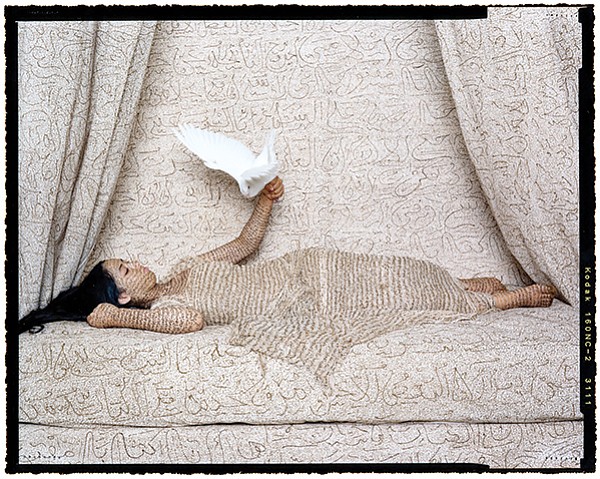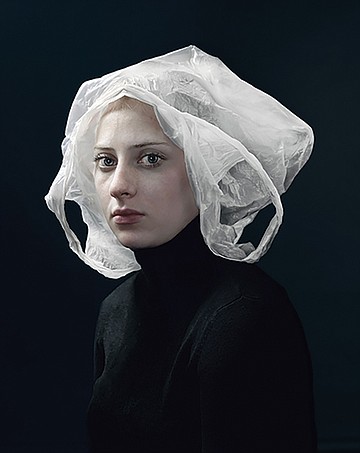 Facebook
Facebook
 X
X
 Instagram
Instagram
 TikTok
TikTok
 Youtube
Youtube

The 9th-century Islamic textile art of washi was an instrument of sexual attraction. Muslim women painted delicate calligraphic messages on tissuey headbands and scarves meant to weaken and lure men. The photographer and painter Lalla Essaydi, born in 1956, grew up in Marrakech in a traditional family. (Her father had four wives.) She married, had children, and lived for years in Saudi Arabia before moving in the 1990s to Paris, where she studied art.
Essaydi’s methods are homey-theatrical and entail a lot of preparation. She spends months designing and dying fabrics for garments and room furnishings on which she writes loosely jointed texts; she chooses an interior, sometimes the actual harem room in the house where she grew up, and invites female friends and family to join her for weeks while they talk and she hennas on their faces, hands, and feet (as caliphs once wrote on their concubines) words that flow from their communal conversations. She poses them, shoots, then digitally manipulates the image. A tight, intense, unsettling selection of her work can be seen at the San Diego Museum of Art.
The poses matter. One image from her series, Le Femmes du Maroc, reimagines Delacroix’s 1834 Orientalist painting , Les Femmes d’Alger, which depicts harem women in various poses of sexual availability and has been used as a motif for many painters since. (Picasso made over a dozen versions.) Essaydi’s version repeats the position of the figures, including one who substitutes for Delacroix’s slave in the painting and draws aside a curtain to reveal the women, but Essaydi’s women don’t “present” to the viewer: each has an inner life made visible but unavailable to us. And virtually every surface — floor, walls, cushions, curtain, costuming — swarms with texts of the women’s conversations, recycling the conversations that took place in actual harems, girl-talk about domesticities — food, children, housekeeping.
Another in the series answers Ingres’s languid, Orientalist nude La Grande Odalisque, but Essaydi’s woman exposes only her arms, shoulders, and the henna-blackened soles of her feet, and her look is a locked-down stare of nearly contemptuous remoteness. It’s a palimpsest: calligraphy-ed over its already-script-flooded surface are broader Arabic characters taken from the artist’s journals. (Another Orientalized Western type recalled in Essaydi’s imagery is Gustave Moreau’s veiled, tattooed Salomé.) What look at first like cloistered environments heavily veiled by (to most of us) indecipherable writing, are exposures, bulletins from a sexually clandestine culture. The most formidably lovely is a photo of three women, backs turned to us, their robes swaddling and eliding head-to-toe the conventional enticements of female physicality, yet these presences carry a sexual jolt of total defiant self-ownership. The same is true of Essaydi’s Harem series of individual women encased not only by a tight interior but by super-elaborate Islamic decorative filigree: sometimes a woman’s garments match and fuse to her surround, as in many of Vuillard’s pictures, so that the emergent hennaed female flesh has a stunning but remote physicality.
Lalla Essaydi: Photographs, on view at the San Diego Museum of Art until August 4, 1450 El Prado, Balboa Park, 619-232-7931; sdmart.org

The Museum of Photographic Arts is showing how another image-maker manipulates his own artistic sources and examines female identity.
The Dutch photographer Hendrik Kerstens was a late starter. At age 40, in 1995 he left his successful wine-importing business and devoted himself to photography. When his daughter Paula was born, he became a stay-at-home father and soon the prepubescent Paula became his primary subject. He’s been making portraits of her for over 20 years. The pictures aren’t at all like Sally Mann’s and Emmett Gowan’s work, where we see their children domestically situated and naturalized. The Paula photos announce themselves as formal, staged, nearly worldless portraits embedded with art historical precedents, especially the Netherlandish painting of Rogier Van der Weyden, Jan Van Eyck, and Petrus Christus.
The pictures have a studied oddness: the deeply modeled features and dramatically sourced lighting (not to speak of Paula’s peachy Dutch beauty), crash into headwear and neck ruffs that cite historical precedents but are made from plastic bags, doilies, exhaust hoses, ropy steel wool wrapped turban-style, a Yankees cap, a helmet out of Rembrandt’s Night Watch crafted from aluminum foil, and a table napkin worn like a wimple. The high professional finish of the images is a result of household industry: Kerstens is self-taught; his wife sees to make-up and set-up; and Paula usually selects the toppings.
These are imposing images, most measuring 40-by-30 inches, digitally finessed to achieve infinitesimally graduated shades of black background and juicy skin tones that seem to keep blooming while you’re looking at them. Paula discloses several types of expectation, as if lending herself to the camera’s gaze with the anxiety of self-exposure or bold self-possessiveness, as if she would never expose herself truly. I kept asking myself what order of beauty I was looking at. Kerstens’s imagery is perfectly of our moment, centuries of composition and coloring flexed by extreme, self-aware, and somehow disingenuous irony. It’s an order of beauty that requires ostentatious precedents that also drills at the foundations of what till now you’ve considered beautiful.
Henrik Kerstens: Model and Muse, at the Museum of Photographic Arts until September 27, 1649 El Prado, 619-238-7559; mopa.org
Histories, part 2, next week.


The 9th-century Islamic textile art of washi was an instrument of sexual attraction. Muslim women painted delicate calligraphic messages on tissuey headbands and scarves meant to weaken and lure men. The photographer and painter Lalla Essaydi, born in 1956, grew up in Marrakech in a traditional family. (Her father had four wives.) She married, had children, and lived for years in Saudi Arabia before moving in the 1990s to Paris, where she studied art.
Essaydi’s methods are homey-theatrical and entail a lot of preparation. She spends months designing and dying fabrics for garments and room furnishings on which she writes loosely jointed texts; she chooses an interior, sometimes the actual harem room in the house where she grew up, and invites female friends and family to join her for weeks while they talk and she hennas on their faces, hands, and feet (as caliphs once wrote on their concubines) words that flow from their communal conversations. She poses them, shoots, then digitally manipulates the image. A tight, intense, unsettling selection of her work can be seen at the San Diego Museum of Art.
The poses matter. One image from her series, Le Femmes du Maroc, reimagines Delacroix’s 1834 Orientalist painting , Les Femmes d’Alger, which depicts harem women in various poses of sexual availability and has been used as a motif for many painters since. (Picasso made over a dozen versions.) Essaydi’s version repeats the position of the figures, including one who substitutes for Delacroix’s slave in the painting and draws aside a curtain to reveal the women, but Essaydi’s women don’t “present” to the viewer: each has an inner life made visible but unavailable to us. And virtually every surface — floor, walls, cushions, curtain, costuming — swarms with texts of the women’s conversations, recycling the conversations that took place in actual harems, girl-talk about domesticities — food, children, housekeeping.
Another in the series answers Ingres’s languid, Orientalist nude La Grande Odalisque, but Essaydi’s woman exposes only her arms, shoulders, and the henna-blackened soles of her feet, and her look is a locked-down stare of nearly contemptuous remoteness. It’s a palimpsest: calligraphy-ed over its already-script-flooded surface are broader Arabic characters taken from the artist’s journals. (Another Orientalized Western type recalled in Essaydi’s imagery is Gustave Moreau’s veiled, tattooed Salomé.) What look at first like cloistered environments heavily veiled by (to most of us) indecipherable writing, are exposures, bulletins from a sexually clandestine culture. The most formidably lovely is a photo of three women, backs turned to us, their robes swaddling and eliding head-to-toe the conventional enticements of female physicality, yet these presences carry a sexual jolt of total defiant self-ownership. The same is true of Essaydi’s Harem series of individual women encased not only by a tight interior but by super-elaborate Islamic decorative filigree: sometimes a woman’s garments match and fuse to her surround, as in many of Vuillard’s pictures, so that the emergent hennaed female flesh has a stunning but remote physicality.
Lalla Essaydi: Photographs, on view at the San Diego Museum of Art until August 4, 1450 El Prado, Balboa Park, 619-232-7931; sdmart.org

The Museum of Photographic Arts is showing how another image-maker manipulates his own artistic sources and examines female identity.
The Dutch photographer Hendrik Kerstens was a late starter. At age 40, in 1995 he left his successful wine-importing business and devoted himself to photography. When his daughter Paula was born, he became a stay-at-home father and soon the prepubescent Paula became his primary subject. He’s been making portraits of her for over 20 years. The pictures aren’t at all like Sally Mann’s and Emmett Gowan’s work, where we see their children domestically situated and naturalized. The Paula photos announce themselves as formal, staged, nearly worldless portraits embedded with art historical precedents, especially the Netherlandish painting of Rogier Van der Weyden, Jan Van Eyck, and Petrus Christus.
The pictures have a studied oddness: the deeply modeled features and dramatically sourced lighting (not to speak of Paula’s peachy Dutch beauty), crash into headwear and neck ruffs that cite historical precedents but are made from plastic bags, doilies, exhaust hoses, ropy steel wool wrapped turban-style, a Yankees cap, a helmet out of Rembrandt’s Night Watch crafted from aluminum foil, and a table napkin worn like a wimple. The high professional finish of the images is a result of household industry: Kerstens is self-taught; his wife sees to make-up and set-up; and Paula usually selects the toppings.
These are imposing images, most measuring 40-by-30 inches, digitally finessed to achieve infinitesimally graduated shades of black background and juicy skin tones that seem to keep blooming while you’re looking at them. Paula discloses several types of expectation, as if lending herself to the camera’s gaze with the anxiety of self-exposure or bold self-possessiveness, as if she would never expose herself truly. I kept asking myself what order of beauty I was looking at. Kerstens’s imagery is perfectly of our moment, centuries of composition and coloring flexed by extreme, self-aware, and somehow disingenuous irony. It’s an order of beauty that requires ostentatious precedents that also drills at the foundations of what till now you’ve considered beautiful.
Henrik Kerstens: Model and Muse, at the Museum of Photographic Arts until September 27, 1649 El Prado, 619-238-7559; mopa.org
Histories, part 2, next week.
Comments